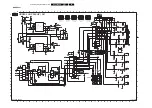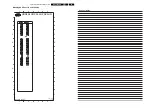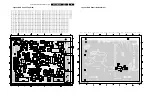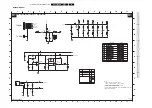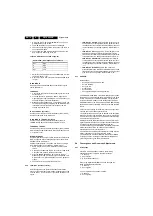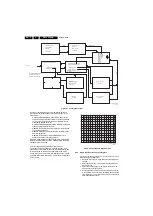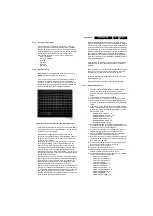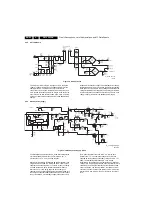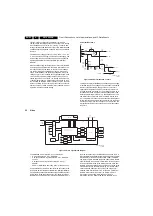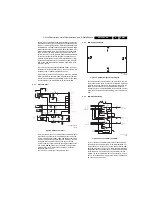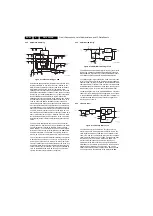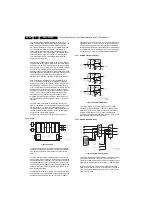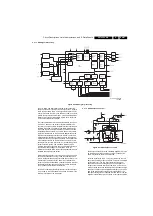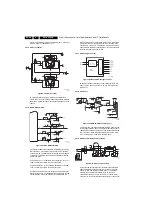
Alignments
EN 73
DPTV565 AA
8.
8.
Alignments
Index of this chapter:
8.1 General Alignment Conditions
8.2 Hardware Alignments
8.3 Software Alignments
8.4 Convergence and Geometry Adjustments
8.5 Option Settings
8.1
General Alignment Conditions
8.1.1
Start Conditions
Perform all electrical adjustments under the following
conditions:
•
Power supply voltage: according to countries standard (
±
10 %).
•
Connect the set to the mains via an isolation transformer
with low internal resistance.
•
Allow the set to warm up for approximately 10 to 20
minutes.
•
Measure the voltages and waveforms in relation to chassis
ground (with the exception of the voltages on the primary
side of the power supply).
Caution: never use the cooling fins/plates as ground.
•
Test probe: Ri > 10 Mohm, Ci < 20 pF.
•
Use an isolated trimmer/screwdriver to perform the
alignments.
8.2
Hardware Alignments
8.2.1
VG2 Set-up
Preferred Method
1.
Connect a Black Level signal to the aerial input of the set.
2.
Preset all G2 controls on the Focus/G2 Combo Block to
minimum (fully CCW).
3.
Connect an Oscilloscope to the Collector of the output
transistor on the Green CRT board. Set the probe to x10.
4.
Adjust the Green G2 control until the Black Level is at 200
V.
5.
Repeat steps 3 and 4 for the Red and Blue CRTs.
Alternate Method
1.
Connect a Black Level signal to the aerial input of the set.
2.
Preset all G2 controls on the Focus/G2 Combo Block to
minimum (fully CCW).
3.
Turn each G2 control clockwise until each CRT is barely
illuminated.
8.2.2
Focus Adjustment
Note: Before beginning the following adjustment procedures
set the customer picture, sharpness, brightness, and tint
controls to midrange and the customer colour control to
minimum.
Electrical Focus Adjustment
1.
Remove the back cover of the set and the light shield, then
turn the set on and inject a crosshatch pattern signal into
the antenna terminal.
Note: The crosshatch pattern will appear clearer if the front
of the screen is covered with a dark cloth.
2.
Cover two of the CRT output lenses with cardboard pieces
(or other non-conductive opaque material) to observe the
magnified reflection of the other picture tube on the
backside of the viewing screen.
3.
Adjust the CRTs focus control (located on the Screen/
Focus Control Block) for the sharpest raster image.
4.
Confirm correct focus by viewing the screen from the front
of the set.
5.
Repeat steps two through four to adjust the focus of the two
remaining CRTs.
Note: Before beginning the following adjustment procedures
set the customer picture, sharpness, brightness, and tint
controls to midrange and the customer colour control to
minimum.
Optical Focus Adjustment
1.
Remove the back cover of the set and the light shield, then
turn these on and inject an NTSC crosshatch pattern signal
into the antenna terminal.
Note: The crosshatch pattern will appear clearer if the front
of the screen is covered with a dark cloth.
2.
Cover tow of the CRT output lenses with cardboard pieces
(or other non-conductive, opaque material) and observe
the magnified reflection of the other picture tube on the
backside of the viewing screen.
3.
Loosen the "lens retaining wing nuts" on the CRT Focus
Assembly.
4.
Move the wing nut in the slot of the uncovered lens to
locate the optimum optical focus viewing the picture from
the back side of the screen), then re-tighten the wing nut.
5.
Confirm correct focus by viewing the screen from the front
of the set.
6.
Repeat steps two through five to adjust the focus of the two
remaining CRTs.
8.3
Software Alignments
With the software alignments, it is possible to align e.g.
Geometry, White Tone, and Tuner IF settings.
Put the set in the SAM (see chapter 5 "Service Modes, Error
Codes, and Faultfinding"). The SAM menu will now appear on
the screen. Select, via the cursor, one of the sub-menus.
Enter the Service Alignment Mode (SAM) by pressing the
following key sequence on the remote control transmitter:
“0-6-2-5-9-6”-[i+]. Do not allow the display to time out while
entering the key sequence. The following menu will appear:
Table 8-1 Alignments menu and default values
8.3.1
General
LUMA GAIN
Fixed setting of "2".
IF AFC
Supply, via a service generator or via off-air, a TV-signal with a
signal strength of at least 1 mV and a frequency of 475.25 MHz
(PAL) or 61.25 MHz (NTSC).
Alignment procedure:
Alignments
Item
Default
General
Luma gain
3
IF AFC
80
IF Lprime AFC
80
Tuner AGC
20
Tuner AGC Tuner 2
8
Blend Intensity
16
Lum. Delay
Lum. Delay Pal B/G
11
Lum. Delay Pal I
8
Lum. Delay Secam
8
Lum. Delay Bypass
11
GDE SAM
See menu on screen
Содержание DPTV565 AA
Страница 27: ...Circuit Diagrams and PWB Layouts 27 DPTV565 AA 7 Layout SSB Top Side E_15000_133 eps 191004 8204 000 6507 3 ...
Страница 29: ...Circuit Diagrams and PWB Layouts 29 DPTV565 AA 7 Layout SSB Bottom Side E_15000_134 eps 191004 8204 000 6507 3 ...
Страница 41: ...Circuit Diagrams and PWB Layouts 41 DPTV565 AA 7 Layout SSM Part 1 Bottom Side F_15020_011a eps 110305 Part 1 ...
Страница 42: ...42 DPTV565 AA 7 Circuit Diagrams and PWB Layouts Layout SSM Part 2 Bottom Side Part 2 F_15020_011b eps 110305 ...
Страница 43: ...Circuit Diagrams and PWB Layouts 43 DPTV565 AA 7 Layout SSM Part 3 Bottom Side F_15020_011c eps 110305 Part 3 ...
Страница 44: ...44 DPTV565 AA 7 Circuit Diagrams and PWB Layouts Layout SSM Part 4 Bottom Side F_15020_011d eps 110305 Part 4 ...
Страница 72: ...72 DPTV565 AA 7 Circuit Diagrams and PWB Layouts Personal Notes E_06532_013 eps 131004 ...
Страница 119: ...Revision List EN 119 DPTV565 AA 11 11 Revision List Manual xxxx xxx xxxx 0 First release ...







